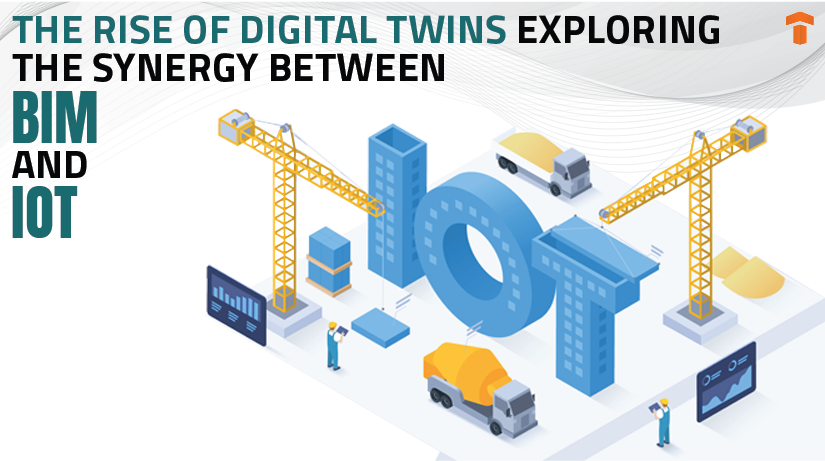The Rise of Digital Twins: Exploring the Synergy Between BIM and IoT
Apr 26, 2024
Category: BIM / Digitization / Automation
Admin

Imagine a city skyline where each skyscraper boasts not only its physical grandeur but also a digital alter ego, whispering secrets of structural integrity, energy efficiency, and occupant behavior. It’s not a scene from a futuristic movie; it’s the reality of the Digital Twin revolution!
According to a survey by Gartner, 13% of organizations that have implemented IoT have already started using digital twins, while 62% plan to use them within a year. This reflects the benefits, such as reducing cycle times of critical processes by 30%, increasing revenue by 10%, and improving product quality by 25%.
BIM is revolutionizing the AEC industry, while IoT is reshaping our interaction with the physical world. This article will discuss the rise of Digital Twins and explore the synergy between BIM and IoT.
Difference between Digital Twin in Construction & BIM
Digital Twin is a virtual representation of a physical asset, such as a building or a construction site, that is connected to its real-world counterpart through IoT sensors and data.
BIM, on the other hand, is a digital representation of the physical and functional characteristics of a building, which enables architects, engineers, and construction professionals to design, simulate, and optimize building performance.
Digital Twin in Construction: A Case Study
Asia’s First Professional Cargo Airport
Bentley Systems, a software development company, used its BIM technology along with iTwin, a Digital Twin technology, to establish a digital twin for the construction of Asia’s first professional cargo airport. This integration of BIM and Digital Twin technologies allowed for real-time monitoring and simulation of the construction process, leading to improved decision-making and efficiency.
This case study illustrates that by creating a virtual replica of the construction project, stakeholders can monitor progress in real-time, anticipate potential issues, and make informed decisions.
BIM and IoT Synergy for Digital Twin in Construction
The synergy between BIM and the IoT is creating a paradigm shift in the construction industry. IoT refers to everyday objects embedded with sensors and software that connect and exchange data. This creates a vast network of intelligent devices, from smart thermostats to industrial machines that can be integrated with BIM.
BIM and IoT together create a digital twin that bridges the gap between the physical and digital worlds.
This allows for:
- Improved design and construction processes: By identifying clashes or conflicts in the design phase using BIM, costly changes during construction are minimized.
- Real-time monitoring of progress: Stakeholders can gain insights into construction progress through the digital twin.
- Predictive maintenance: By analyzing sensor data, the digital twin can predict maintenance needs, optimizing building operations and extending its lifespan.
- Informed decision-making: Throughout the lifecycle, stakeholders can make better choices based on a combination of BIM data and real-time building performance.
Here is one case study “Structure Monitoring of a Bridge Beam Model” that explains they synergy between BIM and IoT.
In this study, researchers proposed an example of a connection between an IoT system and a BIM model for monitoring the deflection of a bridge beam at the centerline. They used a schematic scale model reproduced in the laboratory and modeled in BIM. The developed system allowed real-time connection through the use of a relational database management system (RDBMS) where the sensors transmitted data to the RDBMS, allowing the risk assessment of the real structure.
Conclusion
In the convergence of BIM and IoT lies the transformative potential of Digital Twins in construction. Real-time monitoring, predictive analytics, and enhanced decision-making are just the beginning. As the industry embraces this synergy, TechnoStruct Academy stands ready to equip professionals with the necessary expertise for a future-proof construction landscape.
TechnoStruct Academy offers BIM-IoT integration courses to empower you with the skills to navigate these challenges, so join us today!
FAQs
Q1. What are some applications of digital twins?
Ans. Digital twins are used in various industries, including manufacturing, logistics, and electric vehicles.
Q2. How can digital twins contribute to sustainability goals?
Ans. They can simulate real-world conditions and deliver real-time information, enabling organizations to meet their sustainability goals.
Q3. How is the digital twin market growing?
Ans. The digital twin market is expanding, with a projected CAGR of 30% between 2023 and 2027.







